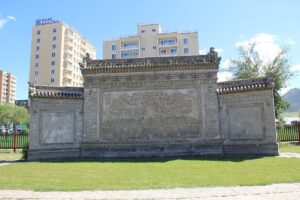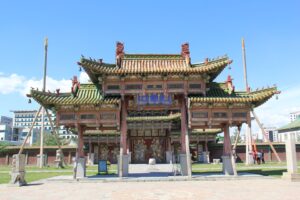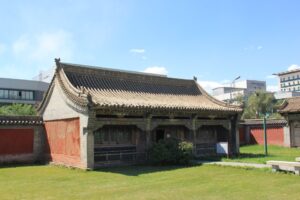The Bogd Khan Palace Museum has been a home to the incarnations named “Bogd Gegeen” since 1639. The museum serves as both a temple and a winter palace where Saint YIII Bogd lived. The monastery comprises 7 palaces that were built between 1893 and 1903. On December 29, 1911, YIII Bogd granted Jibzundamba nobleman the title of “Emperor of great power, who unites the religion and the state of Mongolia” and held a ceremony to honor him.
Yanpai Wall
It serves as a symbol of protection for the temple from hidden evils that cannot be seen. It translates to “closed door” in Tibetan. On the wall, there is a dragon and Mount Sumber, surrounded by the sea, which signifies that evil spirits will fall into the sea and drown.

Asart door
It signifies the “open door” through which Bogd Khan, his queen, and his relatives enter and leave. On the top of the door, it is written “March of the year 33. YIII Bogd Khan” in Mongolian script, Tibetan, and Chinese. On the left and right side, there is a smaller gate, where the guards of the palace, princes of the state, musicians, messengers, and guests of the Bogd king enter.

Chiigan
In front of the gate, there were wooden pillars on both sides, religious and Mongolian state flags were raised.
Amgalan-Enkh Gate
The Gate was created to commemorate Bogd Khan YIII as the supreme ruler of Mongolia. A 7-story roof was made on 8 columns and was assembled with 108 types of puzzles without using a single nail.

Mahranz Temple
The Temple was built in 1903, and inside it were placed the four great kings of Mahranz, who protect the four continents from danger. These are the largest creations made by the wet paper method.
Ravsa or Seruun Asar
The Ravsa or Seruun Asar has a sloping roof with a bell on the left and a tambourine on the right. King Bogd rang bells for the gods of the sky and tambourines for the gods of the earth and water.
Temple of Silk Painting
The Temple was Bogd Khan’s reading room. Buddhist teachings and historical scriptures were transferred to the State Central Library in 1924. The temple has silk paintings created by famous artists and craftsmen of the time, including Gongor of wealth, Tsambagarav, the protector of work, Jamsran, the protector of religion, Bogd Zonkhov, the founder of Zoroastrianism, Manzushir, the god of intelligence, and Damdindorlig, the creator god or talisman of carpenters.
Temple of Painting
The Temple displays portraits from the beginning of the 19th century, including Jigjid Buddha’s thoughts, “Thoughts of Saints,” “A Thousand Gods of Good Time,” “Life of Buddha,” “Buddha and the Eight Bodhisattvas,” showing the life of the Buddha, “Buddha and the Eight Bodhisattvas,” Ayush God, who gives people long life and happiness, and more.
Naidan Temple
In this temple, for the birthday of YIII Bogd Khan, 16 monks painted pictures of the deity for 3 days. When Bogd Khan was expelled from the palace, the tiger’s tail was used to beat the people who gathered to receive blessings from the palace, religious music, Gongervaa decorated with precious stones and covered with gold, objects such as khadag, which were used to bless Bogd Khan’s devotees, juniper drinking vessels made of mahogany, and three idols of age. There are images of the White Mother, Ayush, Jugdernamjil, Zonkhov, the founder of Zoroastrianism, and his two disciples cast in copper and covered with gold.
Temple of Gods
It has gilded figures of Otoch Naiman Manla, Maidar, the 19th-century Tibetan religious leader Banchin Bogd, created by the best Mongolian craftsmen, and the portrait of Lord Tsogdogmarav.
Lavrin Temple
It is the temple where Bogd King used to worship. Assembled in the temple are the First Bogd Zanabazar‘s sculpture, the image of Twenty-one Taras, representing the inner soul of a woman, the portrait of Green Tara, and the incarnation of the Indian monk Jibzundarnath, known as the predecessor of Zanabazar.
Bogd Khan’s Winter Palace
The Bogd Khan’s Winter Palace is a grand two-story building that was constructed in 1903 by the Tsarist Russian builders. The upper floor of the palace comprises a waiting room, a wedding hall, and temporary restrooms for the king and queen’s guests. The waiting room features a fascinating portrait of the capital city from 1912 that was created by the artist Jugder and shows the Capital in the middle of four mountains, including the Winter Palace, Haistai Lavrin (Summer Palace), State Yellow Palace, White Palace, Gandan Monastery, Naimaa City, and Manzushir Monastery. The painting is designed to appear as if it is seen from the sky.
The palace’s meeting hall is impressive, featuring 25 tiered seats where the Bogd Khan used to sit. High-ranking monks occupied the red pad seats, while state ministers sat on the blue pad seats. B. Sharav, the founder of modern Mongolian painting, painted the portrait of Bogd Khan and his queen on the wall. Queen Dondogdulam, who was born in 1874, was named “Mother of the State” in 1911 and passed away in 1923 at the age of 49.
The palace also houses Queen Dondogdulam’s silk robe with nine dragon motifs, a robe with peacock motifs, a collar decorated with peacock feathers, a coral Sampint with pearl motifs, a blue silk lining with a central hem, a brown waistcoat with 8 round pearl motifs / 18000 pearls per round pattern / Rina headdresses, pipes, rings, beauty tables made of silver, pearls, pearls, silver, jeweled headdresses of all colors, jewelry, etc. These artifacts are carefully preserved to showcase the grandeur of the royal dynasty.
The palace holds ivory carvings and silver tools used by Bogd Khan in his religious rituals, which are believed to be talismans that protect against evil and have a vision to intimidate and tame religious heretics. The palace also houses the coral necklace used by Bogd Khan, silver bells and diamonds, the nine dragon robes worn by Bogd Khan, a hat decorated with beaver skin, a silk waistcoat with a Soyombo motif, a gold diamond crown with pearls on all four sides, and 80 sable skins inherited from the Saint Zanabazar.
164 coats of sable skin worn by the janchan and when he was enthroned as the king, foghorns, knives, writing instruments, the king’s and queen’s great thrones, and the state seal box of Bogd Khan were also preserved. The thread of Bogd Khan’s Shashir Khorgoi jacket is gold so it does not burn in fire.
Apart from the robes of the royal monk, Bogd also wore the state ceremonial robes of the royal court. The king wore a long coat of gold over a robe made of yellow Magna. Fus symbols were nailed on the front and back of the jacket and on the left and right shoulders. Soyombo symbols were nailed on the back of the jacket. Soyombo became a symbol of Mongolia becoming an independent country in 1911 and restoring its imperial polity.
Bogd Khan’s pearl-patterned jacket is sewn with a 21-cm-diameter pattern of pearls on yellow silk, and about 22,000 small pearls are woven into one circular pattern. The palace also has a bed made of black mahogany in the king’s and queen’s temporary resting place and bedroom, decorated with silk crepe and precious stones. The walls of the room are adorned with embroidery and paintings made by famous Chinese Manchu artists of that time, and two chairs with music playing as a gift from the Russian king. The palace also houses gifts such as tea sets made of pure silver, jade, and pistachio cups used by the king and queen for their meals, teapots, and ceremonies. Ferment bottles and ceramic vessels used in the period have been preserved.
In the first hall on the ground floor of the Winter Palace, there were large bowls, where those who were late to the feasts organized by the Bogd Palace would drink Airag as a penalty. If he couldn’t explain the reason for being late, he would drink Airag from a 10-liter big cup, but if he could explain it well, he would drink Airag from a small cup or a 5-liter cup.










